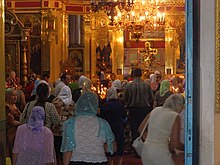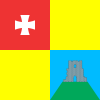Kremenets
Kremenets
Кременець | |
|---|---|
 Kremenets panorama from the Castle Hill | |
Kremenets in Ternopil Oblast | |
| Coordinates: 50°06′29″N 25°43′39″E / 50.10806°N 25.72750°E | |
| Country | |
| Oblast | |
| Raion | |
| Area | |
| • Total | 20.76 km2 (8.02 sq mi) |
| Population (2022) | |
| • Total | 20 476 |
| Time zone | UTC+2 |
| • Summer (DST) | UTC+3 |
 | |
Kremenets (
History



According to some sources the Kremenets fortress was built in the 8th or 9th century, and later became a part of
In the fall of 1648
In 1795 Kremenets was annexed by the
During 1917-1920 Kremenets 7 times passed from hand to hand. The authorities Ukrainian state - Ukrainian People's Republic - it was subject to early 1918 to June 1919.[citation needed]
In 1921, following
In the interwar period, Kremenets was famous for its renowned high school,
In September 1939, the Polish government was temporarily located in Kremenets, which during this time was subject to heavy aerial bombing until captured by invading Soviet forces on 17 September. By then the government had evacuated Kremenets and was on its way to neutral Romania.[4]
On July 28, 1941, most of the teachers of the Krzemieniec High School were arrested by the Germans, who used a list provided to them by local Ukrainians. By the end of the month, 30 teachers and members of Polish intelligentsia were murdered at the so-called Hill of Crosses (Góra Krzyżów).
In January 1989 the population was 24 570 people.[5]
During the restoration of Ukrainian statehood in 1991, was restored Kremenets Botanical Garden (1991), created Kremenetsko-Pochaivskiy State Historical-Architectural Reserve (2001), opened Kremenetskiy Regional Humanitarian Pedagogical Institute n. Shevchenko (2002), Kremenetskiy Regional Museum Juliusz Slowacki (2003), increasing the flow of tourists. In 1991 at the Teachers College Shevchenko created a modern Kremenets Lyceum.
Until 18 July 2020, Kremenets was designated as a city of oblast significance and did not belong to Kremenets Raion even though it was the center of the raion. As part of the administrative reform of Ukraine, which reduced the number of raions of Ternopil Oblast to three, the city was merged into Kremenets Raion.[6][7]
Jews of Kremenets
Jews are known to have settled in the Kremenets area as early as 1438,[8] when the Grand Duke of Lithuania gave them a charter. However, in 1495, Lithuania expelled its Jews until 1503. A Polish Yeshiva, however, operated in Kremenets during the 15th and 16th centuries.[9]
The Jewish community expanded and prospered through the 16th century. Around the middle of the century, rabbinical representatives of the
In 1747, Kremenets was the site of a well-publicized blood libel trial in which 14 Jews were accused of murdering a Christian to obtain blood for making matzo – a false accusation dating back to the Middle Ages. The incident began when an unidentified corpse was found near an inn and curious townsfolk gathered around to view the body. When some Jews joined the crowd, the corpse supposedly began to bleed, thus supernaturally demonstrating their guilt. Twelve of the Jews confessed under torture (placed on the rack and burned with red-hot irons). Most were gruesomely executed by being flayed, quartered and impaled while still alive, by orders of the Christian civil authorities.[12]
Jewish life gradually revived and Kremenets became a secondary center of Haskalah (enlightenment) in Eastern Europe in the period 1772 through 1781.[13] By the end of the 19th century, Jews once again were active in the economic life of the town, primarily in the paper industry and as cobblers and carpenters. They exported their goods to other towns in Russia and Poland.[14] Under Polish rule, in the early 1930s, two Yiddish periodicals were published. They merged in 1933 into a single weekly newspaper, Kremenitser Lebn (Kremenets Life).[14]
The Soviet authorities annexed the town on September 22, 1939. In the spring of 1940, the refugees from western Poland were obliged to register with the authorities and to declare whether they wished to take up
Holocaust
The Nazis destroyed the Jewish community of Kremenets. Except for those who left Kremenets before the war and 14 survivors, all 15,000 Jews who lived in Kremenets in 1941 were murdered.
In June 1941, the German
"A few days after the German-Soviet war broke out (June 22, 1941) the Germans reached the area. Hundreds of young Jews managed to flee to the Soviet Union. A pogrom broke out in early July 1941, where 800 men, women and children were killed. In August 1941 the Gestapo ordered all Jews with academic status to report for registration. All those who did so were murdered, and the Jewish community's leadership was destroyed. That month the Germans set fire to the main synagogue and exacted a fine of 11 kg. of gold from the community.
A Judenrat was imposed. The head, Benjamin Katz was murdered for his refusal to collaborate with the Nazis. At the end of January 1942 a ghetto was established and on March 1 was closed off from the rest of the city. The inmates endured great hardship and there was a serious shortage of water.[16]
In the summer of 1942, the Germans began the systematic liquidation of the ghettos in the provincial towns. On July 22, 1942, there was armed resistance by the Jews of the Kremenets ghetto against the Germans.[17]
On August 10, 1942, the Germans initiated a two-week-long Aktion to annihilate the Jews of the Kremenets Ghetto, Fifteen hundred able-bodied persons were dispatched as
Although the Jewish presence in Kremenets was physically destroyed, the memory of Jewish Kremenetsers lived on. In the postwar years, those who successfully emigrated before the onset of hostilities, survivors of the
Economy

Today the economy of Kremenets is supported by Orthodox pilgrims who come to visit the cathedrals, the nunnery, and the nearby
Points of interest
- complex of a former Jesuit college, which housed the Saint Ignatius of Loyola church,
- Stanislaus of Szczepanow Roman Catholic church, built in 1853–1857, with a monument of Juliusz Slowacki inside. In Soviet Union, it served as a gym, currently it belongs to Ukrainian Orthodox Church,
- female Orthodox monastery, which continues the traditions of a 1636 monastery. In the Second Polish Republic, it was the seat of Orthodox Volhynian Bishops.
- Cabinet of Ministers of Ukrainefrom October 12, 1992 declared the Kremenets Botanical Garden as a protected area of national importance, which aims are to preserve, study, acclimate rare and common flora.
Notable people
Ukrainian
- Comintern
- Oleksander Osetsky – general in the army of the Ukrainian People's Republic (UNR)
- Andriy Pushkar – armwrestler, world champion
- Vitaliy Shumbarets – world cup ski jumper
- Vita Palazuelos — renowned United States prosecutor
Poles
- Jozef Antoni Beaupre – physician and patriotic activist, graduate of the Krzemieniec high school
- Tadeusz Czacki – social activist, historian, born in nearby Poryck, founder of the Krzemieniec Lyceum
- Aleksander Czekanowski – geologist and explorer of Siberia
- Joanna Duda-Gwiazda – oppositional activist in Communist Poland, wife of Andrzej Gwiazda
- Paweł Giżycki – Baroque era architect, painter, Jesuit priest
- Jerzy Litwiniuk – poet and translator
- Zygmunt Rumel – poet and resistance fighter, murdered by Ukrainian nationalists on July 10, 1943
- Irena Sandecka – poet, social activist and teacher
- Juliusz Słowacki – romantic poet
- Salomea Słowacka – mother of Juliusz Slowacki, buried at the local cemetery
- Wroclaw University
Jews
- Mark Kac – mathematical physicist
- Jacob Schaefer - composer and choral director
- Isaac Stern – violin virtuoso
Other
- José Antonio Saravia - general
- Joseph Saunders (engraver) (1773-1854), English printmaker, lived and died here
References
- ^ ISBN 9781841624501.
- ^ "Кременецкая городская громада" (in Russian). Портал об'єднаних громад України.
- ^ Чисельність наявного населення України на 1 січня 2022 [Number of Present Population of Ukraine, as of January 1, 2022] (PDF) (in Ukrainian and English). Kyiv: State Statistics Service of Ukraine. Archived (PDF) from the original on 4 July 2022.
- ^ Archived copy Archived 2021-10-18 at the Wayback Machine [permanent dead link]
- ^ Всесоюзная перепись населения 1989 г. Численность городского населения союзных республик, их территориальных единиц, городских поселений и городских районов по полу
- ^ "Про утворення та ліквідацію районів. Постанова Верховної Ради України № 807-ІХ". Голос України (in Ukrainian). 2020-07-18. Retrieved 2020-10-03.
- ^ "Нові райони: карти + склад" (in Ukrainian). Міністерство розвитку громад та територій України.
- ^ Simon Wiesenthal
- ^ Barnavi, p. 143.
- Dubnow, vol. I, pp. 109–110.
- ^ Simon Wiesenthal, Encyclopedia Judaica
- ^ "Learn about Kremenets". kehilalinks.jewishgen.org.
- ^ Barnavi, p. 177.
- ^ a b Encyclopedia Judaica
- ^ a b Encyclopedia Judaica.
- Encyclopedia Judaica
- ^ JewishGen: Holocaust
External links
- Illustrated guide of Krzemieniec, published in Lutsk in 1929
- Volodymyr Kubijovyč, Kremenets in Encyclopedia of Ukraine, vol. 2 (1989). (in English) (Encyclopedia of Ukraine)
- Kremenets, Ukraine at JewishGen




